HVOEC Hears About Raft of Issues at Spring Dinner
Proposed climate change legislation, electrification as an overall energy policy, a “Green New Deal,” a carbon tax—these are among the challenges the industry faces from the New York State legislature or New York Gov. Andrew Cuomo, members of the Hudson Valley Oil and Energy Council were told at their May 15 Spring Dinner and Trade Show at Spruce Lodge in Montgomery, N.Y.
Emilio Petroccione, legislative and regulatory attorney for the Empire State Energy Association, briefed the attendees. Another challenge Petroccione noted was the proposed Williams pipeline, which would transmit natural gas from Pennsylvania to New Jersey and New York City.

Barry Knox of Renewable Energy Group delivered an update on biofuels and Bioheat. REG, based in Ames, Iowa, is developing biodiesel blending capabilities with Broco Oil at a Broco Oil facility in Haverhill, Mass. The facility is expected to serve as a distribution hub for the Northeast. (See story, pg. 42, June 2019 Fuel Oil News.)
Cuomo in January announced a New York State version of the “Green New Deal,” modeled after one that was previously floated, primarily by progressives, in Congress. The governor described his proposal as a clean energy and jobs agenda designed to “aggressively put New York State on a path to economy-wide carbon neutrality.
“Climate change is a reality, and the consequences of delay are a matter of life and death. We know what we must do. Now we have to have the vision, the courage, and the competence to get it done,” Cuomo said in announcing the plan. “While the federal government shamefully ignores the reality of climate change and fails to take meaningful action, we are launching the first-in-the-nation Green New Deal to seize the potential of the clean energy economy, set nation’s most ambitious goal for carbon-free power, and ultimately eliminate our entire carbon footprint.”
During Cuomo’s first two terms, New York banned fracking of natural gas, committed to phasing out coal power by 2020, mandated 50% renewable power by 2030, and established the U.S. Climate Alliance to uphold the Paris Agreement. Under the Reforming the Energy Vision agenda, New York has made large renewable energy procurements, solar has increased, and offshore wind is poised to transform the state’s electricity supply to be cleaner and more sustainable, the governor said.
As proposed, the Green New Deal would statutorily mandate New York’s power be 100% carbon-free by 2040. Cuomo called it “the most aggressive goal in the United States and five years ahead of a target recently adopted by California.” The cornerstone of the mandate is an increase of New York’s Clean Energy Standard from 50% to 70% renewable electricity by 2030. The ramp-up of renewable energy would include:
Quadrupling New York’s offshore wind target to 9,000 megawatts by 2035, up from 2,400 megawatts by 2030
Doubling distributed solar deployment to 6,000 megawatts by 2025, up from 3,000 megawatts by 2023
More than doubling new large-scale land-based wind and solar resources through the Clean Energy Standard
Maximizing the contributions and potential of New York’s existing renewable resources
Deploying 3,000 megawatts of energy storage by 2030, up from 1,500 megawatts by 2025
The Green New Deal also would create the state’s first statutory Climate Action Council, comprising heads of relevant state agencies and other workforce, environmental justice, and clean energy experts to develop a comprehensive plan to make New York carbon neutral by reducing emissions from all major sources, including electricity, transportation, buildings, industry, commercial activity, and agriculture, Cuomo said. The Climate Action Council would consider a range of possible options, including the feasibility of working with the U.S. Climate Alliance to create a new multistate emissions reduction program that covers all sectors of the economy, including transportation and industry, and exploring ways to leverage the successful Regional Greenhouse Gas Initiative to drive transformational investment in the clean energy economy and support a just transition, according to the governor’s statement.
This article is based on a news release issued by Gov. Andrew Cuomo’s office, and reporting by Stephen Bennett.
